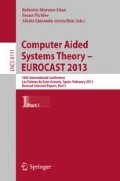Abstract
In contrast to sampling a signal at equidistant points in time the on-delta-send sampling principle relies on discretizing the signal due to equidistant points in the range. On-delta-send sampling is encountered in asynchronous event-based data acquisition of wireless sensor networks in order to reduce the amount of data transfer, in event-based imaging in order to realize high-dynamic range image acquisition or, via the integrate-and-fire principle, in biology in terms of neuronal spike trains. It turns out that the set of event sequences that result from a bounded set of signals by applying on-delta-send sampling can be characterized by means of the ball with respect to the so-called discrepancy norm as metric. This metric relies on a maximal principle that evaluates intervals of maximal partial sums. It is discussed how this property can be used to construct novel matching algorithms for such sequences. Simulations based on test signals show its pontential above all regarding robustness.
Access this chapter
Tax calculation will be finalised at checkout
Purchases are for personal use only
Preview
Unable to display preview. Download preview PDF.
References
Bauer, P., Bodenhofer, U., Klement, E.P.: A fuzzy algorithm for pixel classification based on the discrepancy norm. In: Proc. 5th IEEE Int. Conf. on Fuzzy Systems, New Orleans, LA, vol. III, pp. 2007–2012 (September 1996)
Bellman, R.E.: Dynamic Programming. Dover Publications, Incorporated (2003)
Chan, V., Liu, S.-C., van Schaik, A.: AER EAR: A matched silicon cochlea pair with address event representation interface. IEEE Transactions on Circuits and Systems I 54(1), 48–59 (2007)
Chazelle, B.: The Discrepancy Method: Randomness and Complexity. Cambridge University Press, New York (2000)
Drazen, D., Lichtsteiner, P., Häfliger, P., Delbrück, T., Jensen, A.: Toward real-time particle tracking using an event-based dynamic vision sensor. Experiments in Fluids 51, 1465–1469 (2011), doi:10.1007/s00348-011-1207-y
Hofstätter, M., Litzenberger, M., Matolin, D., Posch, C.: Hardware-accelerated address-event processing for high-speed visual object recognition. In: ICECS, pp. 89–92 (2011)
Miskowicz, M.: Send-on-delta concept: An event-based data reporting strategy. Sensors 6(1), 49–63 (2006)
Moser, B.: A similarity measure for image and volumetric data based on Hermann Weyl’s discrepancy. IEEE Trans. Pattern Analysis and Machine Intelligence 33(11), 2321–2329 (2011)
Moser, B.: Geometric characterization of Weyl’s discrepancy norm in terms of its n-dimensional unit balls. Discrete and Computational Geometry, 1–14 (2012)
Moser, B., Stübl, G., Bouchot, J.-L.: On a non-monotonicity effect of similarity measures. In: Pelillo, M., Hancock, E.R. (eds.) SIMBAD 2011. LNCS, vol. 7005, pp. 46–60. Springer, Heidelberg (2011)
Niederreiter, H.: Random Number Generation and Quasi-Monte Carlo Methods. Society for Industrial and Applied Mathematics, Philadelphia (1992)
Stübl, G., Bouchot, J.-L., Haslinger, P., Moser, B.: Discrepancy norm as fitness function for defect detection on regularly textured surfaces. In: Pinz, A., Pock, T., Bischof, H., Leberl, F. (eds.) DAGM/OAGM 2012. LNCS, vol. 7476, pp. 428–437. Springer, Heidelberg (2012)
van Rossum, M.C.W.: A novel spike distance. Neural Computation 13(4), 751–763 (2001)
Victor, J.D.: Spike train metrics. Current Opinion in Neurobiology 15(5), 585–592 (2005)
Victor, J.D., Purpura, K.P.: Nature and precision of temporal coding in visual cortex: a metric-space analysis. Journal of Neurophysiology 76(2), 1310–1326 (1996)
Weyl, H.: Über die Gleichverteilung von Zahlen mod. Eins. Mathematische Annalen 77, 313–352 (1916)
Yilmaz, Y., Moustakides, G.V., Wang, X.: Channel-aware decentralized detection via level-triggered sampling. CoRR, abs/1205.5906 (2012)
Zhao, Y.-B., Liu, G.-P., Rees, D.: Using deadband in packet-based networked control systems. In: Proceedings of the 2009 IEEE International Conference on Systems, Man and Cybernetics, SMC 2009, pp. 2818–2823. IEEE Press, Piscataway (2009)
Author information
Authors and Affiliations
Editor information
Editors and Affiliations
Rights and permissions
Copyright information
© 2013 Springer-Verlag Berlin Heidelberg
About this paper
Cite this paper
Moser, B., Eibensteiner, F., Kogler, J., Stübl, G. (2013). On the Relevance of Discrepancy Norm for Similarity-Based Clustering of Delta-Event Sequences. In: Moreno-Díaz, R., Pichler, F., Quesada-Arencibia, A. (eds) Computer Aided Systems Theory - EUROCAST 2013. EUROCAST 2013. Lecture Notes in Computer Science, vol 8111. Springer, Berlin, Heidelberg. https://doi.org/10.1007/978-3-642-53856-8_11
Download citation
DOI: https://doi.org/10.1007/978-3-642-53856-8_11
Publisher Name: Springer, Berlin, Heidelberg
Print ISBN: 978-3-642-53855-1
Online ISBN: 978-3-642-53856-8
eBook Packages: Computer ScienceComputer Science (R0)

